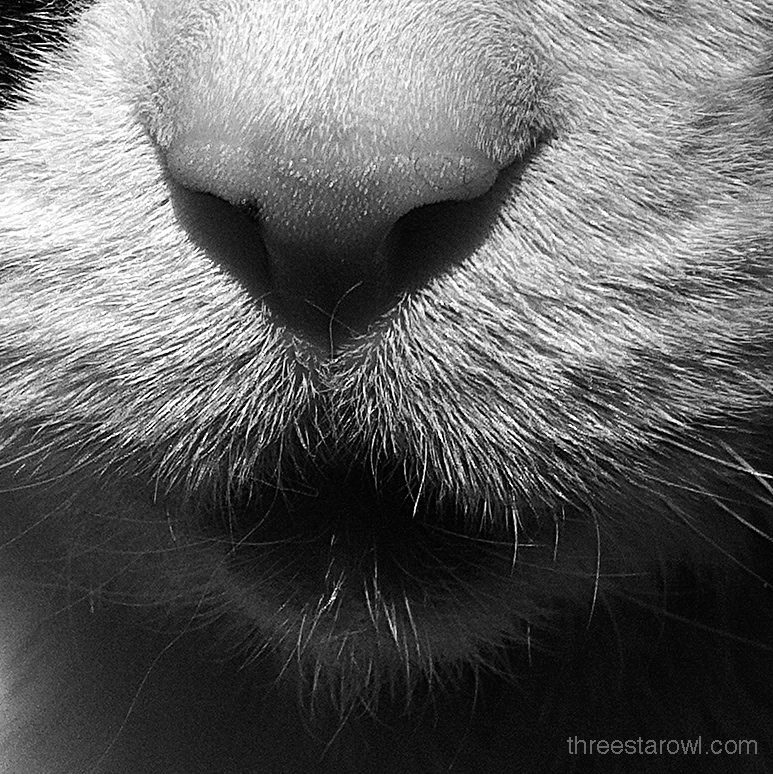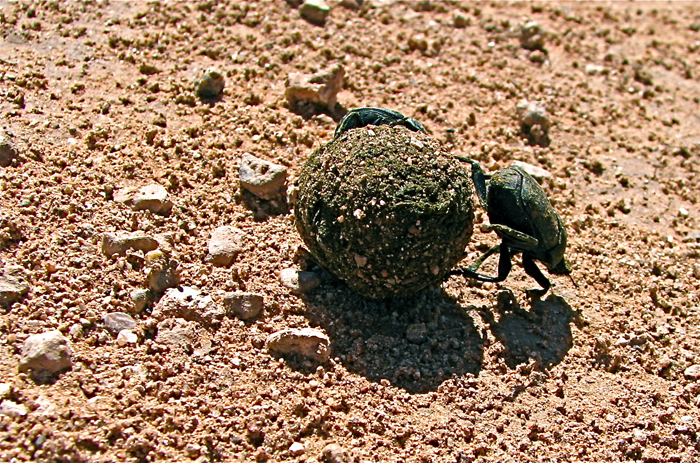The Mystery of the One-armed Bandit and other Tales of the Cold War
Just a few days ago, we experienced a rare deep-freeze in the Southwest deserts. During a normal winter it can get cold in the low desert — not Canada cold, or even Iowa cold, of course — but this was an unusually lengthy and deep cold for our desert, sinking well below freezing for several nights running, and not warming up past the mid-40s during the day.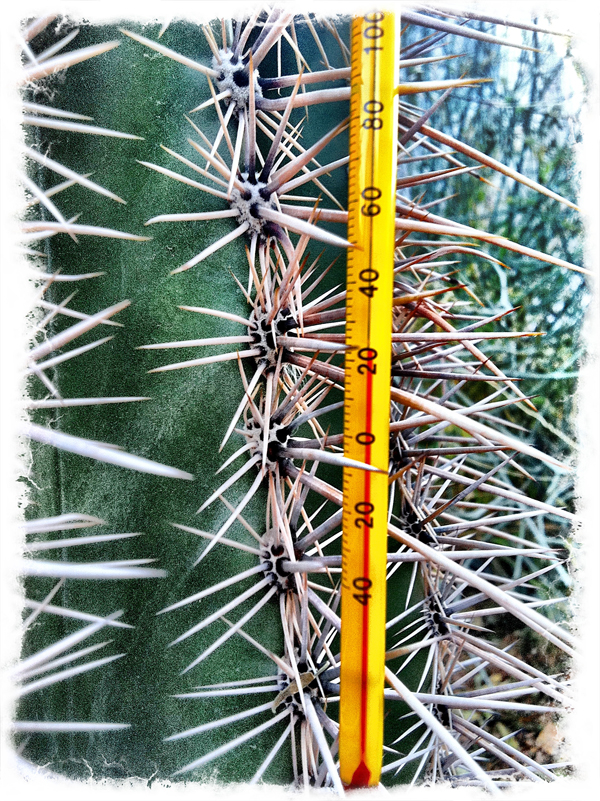 One spot in our yard went below 20F for three nights in a row. That’s enough to cause trauma and die-back even in hardy native plants. Birds spend long daylight hours feeding frantically at both natural and human-provided food sources; mammals, too, unless they’re equipped to shelter in cavities, crevices, or caves, or underground like the local reptiles and arthropods.
One spot in our yard went below 20F for three nights in a row. That’s enough to cause trauma and die-back even in hardy native plants. Birds spend long daylight hours feeding frantically at both natural and human-provided food sources; mammals, too, unless they’re equipped to shelter in cavities, crevices, or caves, or underground like the local reptiles and arthropods.
<< Old-school thermometer hung in a young saguaro in the cold part of our yard
Cold-powered hunger also can make animals “tame” — fearless hummingbirds slurp at feeders as they’re being carried out to the trees, and aloof night-time hunters like owls and coyotes will boldly stretch their workdays into sunlit hours, and onto back porches and front yards. This boldness can increase success in finding nourishment, but it also increases exposure, which can be risky for animals who rely on not being seen for both safety and effective foraging. Traveling in California during an extreme coldsnap many years ago, E and I saw three bobcats in a week, because the stealthy nocturnal predators were out in daylight hours hunting sparrows and small mammals themselves made unusually unwary by the desperation of hunger.
But a mitigating feature of desert freezes is how quickly warmth follows cold. There’s no lengthy spring warm-up. Within a day or two of our arctic chill, daytime temps have already bounced up to the 70s, 10F degrees above the seasonal average. Expert survivalists don’t waste this advantage: as soon as the sun can warm air and soil again and melt pools and trickles, animals re-appear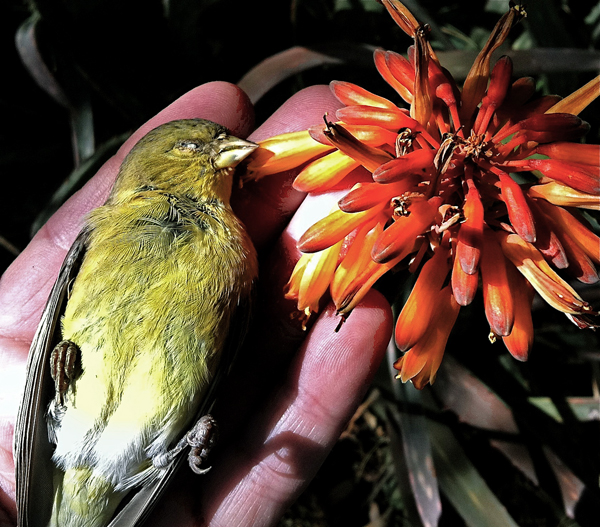 in search of food. This morning I spotted a coyote foraging in the neighbors’ front yard in broad daylight. After a cold snap, temperatures may rebound quickly, but cold leaves many animals hungrier than usual, and without whichever of their plant or small-animal food resources that succumbed to the cold. In the days and weeks afterwards, sometimes extraordinary tactics are required for survival.
in search of food. This morning I spotted a coyote foraging in the neighbors’ front yard in broad daylight. After a cold snap, temperatures may rebound quickly, but cold leaves many animals hungrier than usual, and without whichever of their plant or small-animal food resources that succumbed to the cold. In the days and weeks afterwards, sometimes extraordinary tactics are required for survival.
>> An aloe blossom that survived, and a female Lesser Goldfinch who didn’t (photo A.Shock)
That might explain E‘s sighting of a Stripe-tailed scorpion (Hoffmannius/Væjovis spinigerus) scuttling about on our driveway the other evening at sunset. We seldom see scorpions moving around in our yard — believe me, I’ve tried, black-light and all. Sadly, most of our encounters with these efficient nocturnal predators are with drowning victims in the pool. And NEVER in winter — they seek shelter as soon as the weather gets cold, and don’t reappear until it’s balmy again. For an exothermic organism, there’s no point in being out and about in the cold, expending energy at a time when their arthropod prey is hibernating, making it hard to recover the calories lost in fruitless hunting.
Yet, here was a striper in our driveway. Maybe it was forced by the cold to come out to try for a m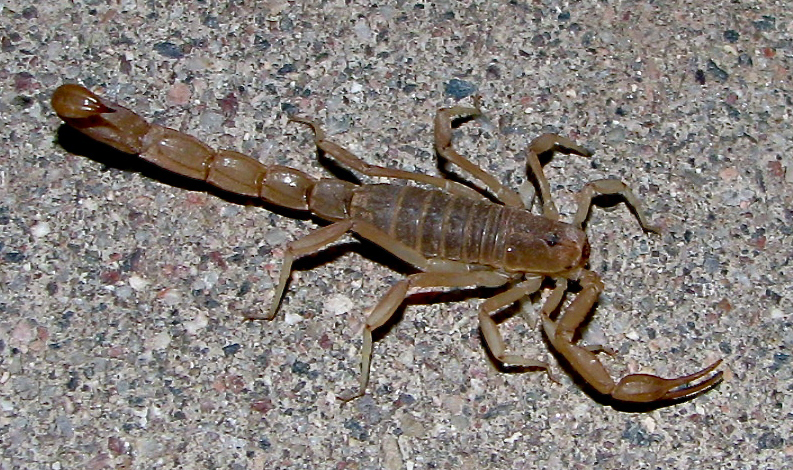 eal to boost its caloric resources so it could survive the rest of its hibernation. Maybe its lack of left-hand grasping pincer meant it had gone into winter with fewer reserves under its exoskeleton. What its story is we’ll never know for sure. But my hunch is that our efforts at salvaging succulents contributed to its untimely emergence. We had stashed most of E’s tender cactus and succulents in the garage when the temps plunged. Maybe this guy was wintering in a planter, and tempted by the relatively warm dark of the garage, wandered out trying to steal a march on spring. E snapped a couple pix for me, and let it go on its way, to whatever resolution it could manage.
eal to boost its caloric resources so it could survive the rest of its hibernation. Maybe its lack of left-hand grasping pincer meant it had gone into winter with fewer reserves under its exoskeleton. What its story is we’ll never know for sure. But my hunch is that our efforts at salvaging succulents contributed to its untimely emergence. We had stashed most of E’s tender cactus and succulents in the garage when the temps plunged. Maybe this guy was wintering in a planter, and tempted by the relatively warm dark of the garage, wandered out trying to steal a march on spring. E snapped a couple pix for me, and let it go on its way, to whatever resolution it could manage.
Good luck to it in its wanderings to find dinner and a new refuge. But I wonder what that hunger sharpened coyote was rummaging for so hopefully across the street “after hours” this morning? Sometimes it’s the late bird that gets the worm.
It was just sitting there…
…so I walked up to it and took its picture.
It’s an immature Costa’s hummingbird sitting on a thorny throne below the deep dark of our Texas Ebony’s canopy. 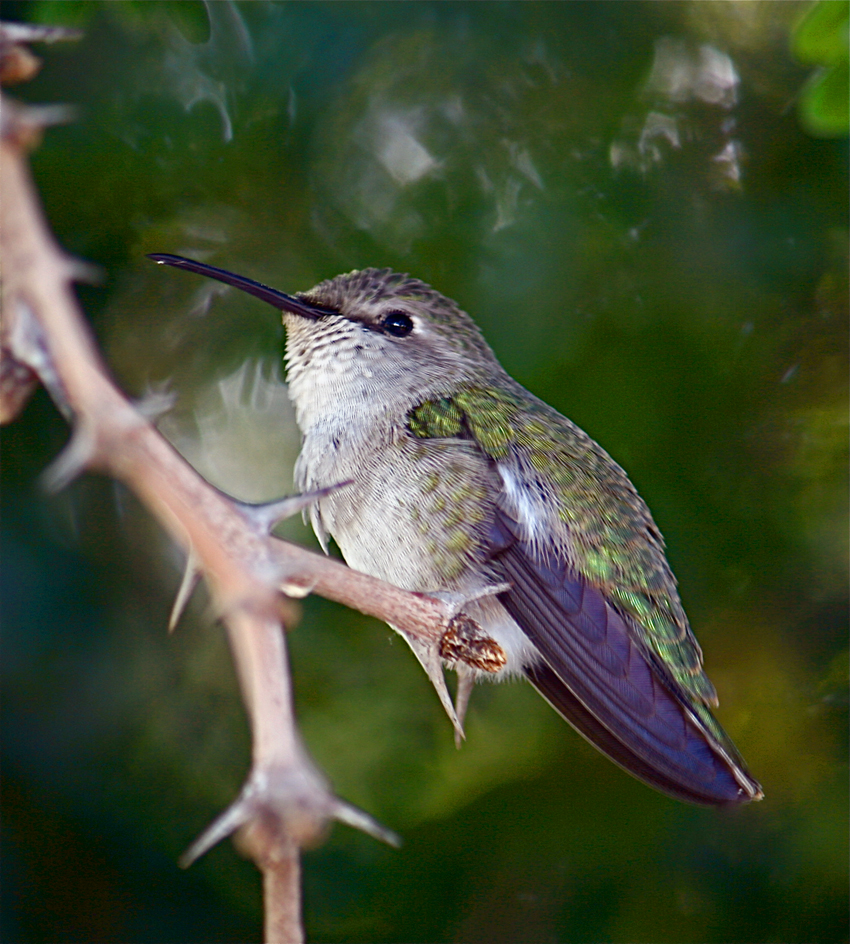 Imperfectly sharp as it is, it was a lucky shot in the shade — with no flash, trying to hold the telephoto lens still. There are thirty other perfectly un-sharp images to prove it.
Imperfectly sharp as it is, it was a lucky shot in the shade — with no flash, trying to hold the telephoto lens still. There are thirty other perfectly un-sharp images to prove it.
Costa’s hummingbird (photo A.Shock) >>
It did not care in the least that I was stealing its soul with my camera — probably a soul would just weigh a hummer down anyway, and this one had gnats to nab and intruders to chase. I was happy to catch it in its late afternoon moment of calm.
Just a pretty
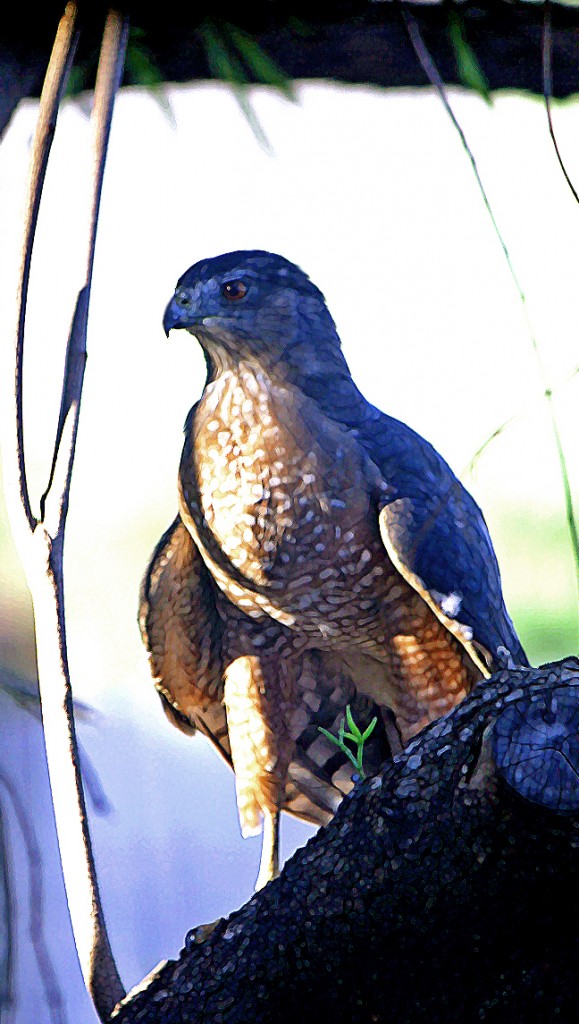 Here’s some eye-candy to bring in the new month: a Photoshop-edited photo of the Cooper’s hawk (who may have eaten Hoover) I posted about a few days ago >>
Here’s some eye-candy to bring in the new month: a Photoshop-edited photo of the Cooper’s hawk (who may have eaten Hoover) I posted about a few days ago >>
Sometimes what begins as a technically sub-standard photographic capture — like this image taken in difficult light through grimy double-paned glass, a bug screen, and security bars — can be salvaged with a little (or a lot!) of editing. Don’t think of it as photography at all, because that’s only the starting point. You can argue either way whether it’s art or not, but it is good illustration, because it clearly shows the tough-guy attitude these fierce smallish hawks emit: “Just keep stuffing down there below the feeders, you lot! I will eat you, fat happy doves…. now or later, you are mine… and I will eat you.”
Subsequent “toad” extractions
‘Tis the Season.
Every morning when I get up, I check the pool for unintentional overnight swimmers. Usually there’s nothing, 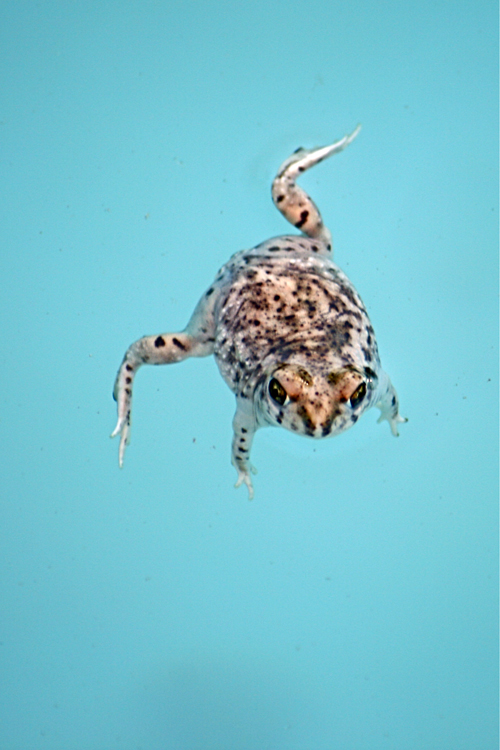 but when there is it’s often a sunspider, or a scorpion, or beetle; sometimes it’s a hapless mammal like a pocket mouse. Sometimes it’s a rescue, sometimes a recovery, to use the clear but courteously oblique terms of search and rescue.
but when there is it’s often a sunspider, or a scorpion, or beetle; sometimes it’s a hapless mammal like a pocket mouse. Sometimes it’s a rescue, sometimes a recovery, to use the clear but courteously oblique terms of search and rescue.
>> hatchling afloat contemplating options, fully aware of looming predators, uncertain of their intentions
This time of year — at least this year — it’s spadefoot hatchlings. We seem to have successfully hosted a batch of hatch of these Sonoran native amphibians (toad-like but technically not, more accurately referred to as a toad-like amphibian — the way a javelina is not an actual pig, Sus, but a pig-like mammal). We are happy and proud, of course, but a little surprised, since we thought our local population of Couch’s spadefoots had dried up. Up to this point, we weren’t sure our 2008 efforts at re-introduction (read here) positively took, and we haven’t heard their sheep-like bleating mating calls this year, despite several seemingly appropriate thunder-blasting, downpouring monsoon storms of the sort we’re assured is considered by “toads” to be romantically stimulating.
Yet here they are in our yard, Couch’s spadefoot hatchlings, and so the resulting morning pool check is carried out. Usually this is what happens: I go out, check the strainer, the hose, the tile water line, the open water, the bottom (for victims, although we’ve never found a drowned toad), and fail to find a “toad”. Then an hour later E goes out and announces, “A! ‘Toad’!” (“Janet! Donkeys!”) From this we know that either a) the toads are jumping in after sunrise, or b) I’m blind to Couch’s spadefoots. Since a tiny ‘toad’ throws hard-to-miss ripples from its bi-lateral, efficient 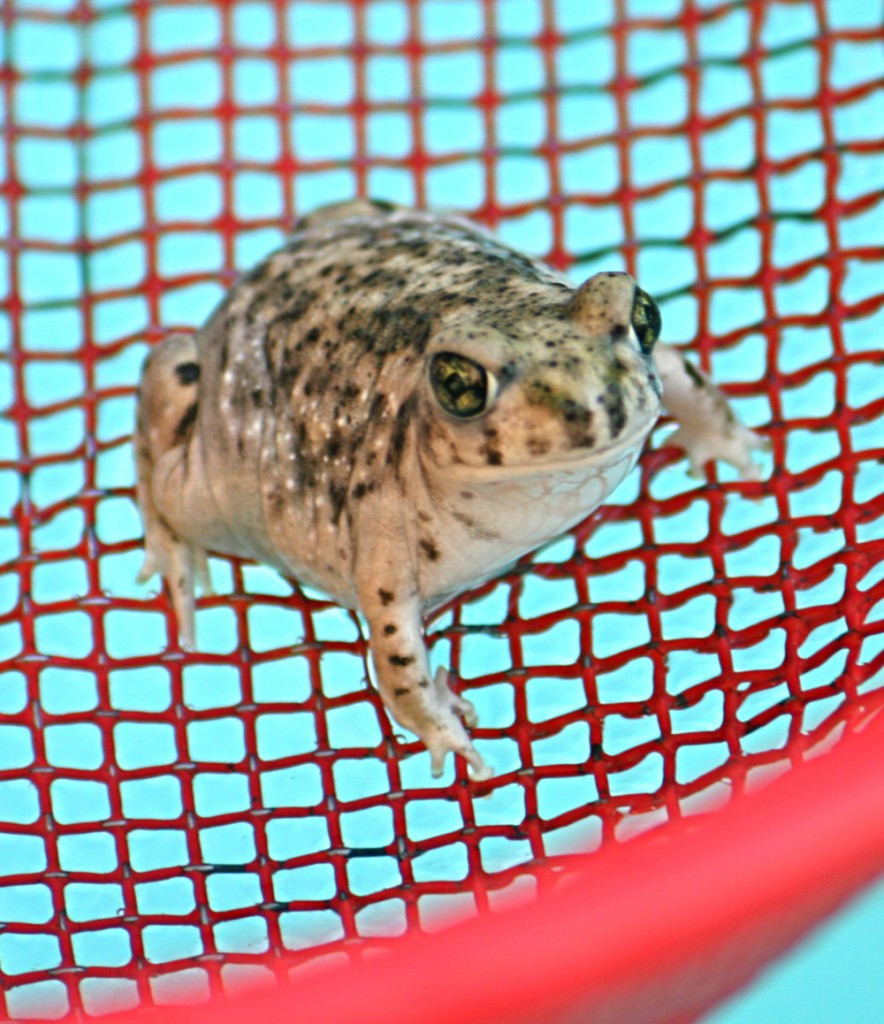 frog-kicking tour around the perimeter, we think it must be a). a) is the more desirable answer because it means that the “toadlets” aren’t spending a long time in a water feature they can’t climb out of (we do have various ramp-like structures set up for self-extraction from the pool, but smaller animals don’t always find their way to them). Answer a) also means I’m not blind to “toads.”
frog-kicking tour around the perimeter, we think it must be a). a) is the more desirable answer because it means that the “toadlets” aren’t spending a long time in a water feature they can’t climb out of (we do have various ramp-like structures set up for self-extraction from the pool, but smaller animals don’t always find their way to them). Answer a) also means I’m not blind to “toads.”
<< scooped up in a kitchen strainer, not an inch long
The paddler we rescued this morning — pictured in this post, both images — appears to be a lighter “toad” than the last one rescued, with more highly contrasty spots, which is an indication we’re probably dealing with a batch rather than a one-off. Hurray spadefoots! You’re welcome to use our overgrown, puppy-dog-free yard as a nursery any time!
(Photos A.Shock — they’re large files, click for better look. Check out the blood supply in delicate veins on throat in bottom photo, and a glimpse of dark spade on rear feet of upper photo)
Touch the Tiny Toad!
Monday was International Touch the Tiny Toad Day, with bonus Whiptail. I guess the whiptail makes it more correctly International Touch the Reptile Day, except it wasn’t international, it was just in our yard, and a toad isn’t a reptile, but then again, it was a tiny Spadefoot, whic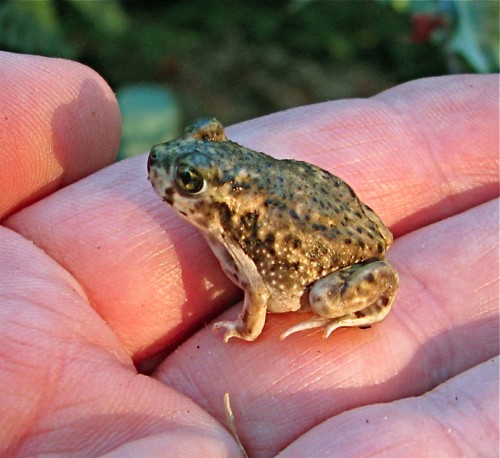 h isn’t a toad but a toad-like amphibian, although an amphibian still isn’t a reptile. But it was tiny, and I touched it.
h isn’t a toad but a toad-like amphibian, although an amphibian still isn’t a reptile. But it was tiny, and I touched it.
Couch’s Spadefoot, Scaphiopus couchii, (photo E.Shock) >>
At any rate, I ended the day having made contact with two herptiles: a Spadefoot toadlet which E rescued out of the pool and I held on my palm while he snapped its portrait in the rosy light of sunset, and a Sonoran Tiger Whiptail (Aspidoscelis tigris punctilinealis) which I’d rescued out of the pool earlier but didn’t get a picture of because it zipped into the cover of the fan palm as soon as I lifted it onto the deck.
Normally I go weeks if not months between making direct contact with a yard herp, so this was a kind of blue moon event, as far as handling neighborhood non-mammals goes. Both whiptails and spadefoots have very soft, smooth belly skin, cool and heavy like silk. (FYI: if you ever find a whiptail in your pool, go ahead and rescue it by hand — I’ve never had one try to bite, unlike some other lizards I could mention. If you rescue a spadefoot — or any toad — wash your hands afterwards: many have toxins in their skin, and Couch’s toxins pack an eye-swelling wallop, I understand.)
The question remains: was this tiny toadlike toddler an offspring of one of the Couch’s spadefoots we released in September 2008? It’s about the same size as those hatchlings were — that would make today’s youngster “young of the year”,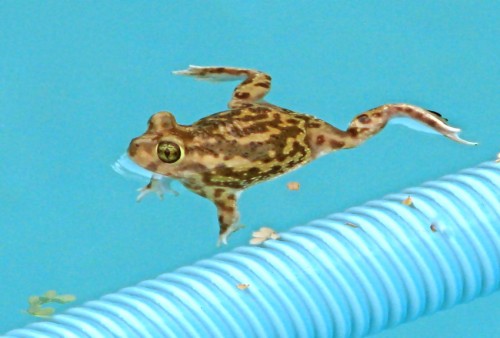 and the first evidence that our releases had reproduced. (Of course, it could have washed in from uphill during the August flash flood.) But still, in past years we’ve found larger spadefoots in the pool (right>>) which we’ve assumed were “ours” from ’08, and they were way bigger than this lil dude, so we’re figuring he’s a subsequent generation.
and the first evidence that our releases had reproduced. (Of course, it could have washed in from uphill during the August flash flood.) But still, in past years we’ve found larger spadefoots in the pool (right>>) which we’ve assumed were “ours” from ’08, and they were way bigger than this lil dude, so we’re figuring he’s a subsequent generation.
In the top picture, take a look at the spadefoot’s hind leg, underneath his foot. See that small black dash that looks like a piece of crud on my hand? That’s his little “spade”: a hard, dark digging organ situated under each back foot, which gives him his name in both English (spadefoot) and Greek (scaphiopus). Actually, you can also see it on the left foot of the spadefoot in the pool photo, too. Click on this link to the Calherps website to see lots of Couch’s spadefoot photos, and scroll to the very bottom to see great shots of their spades.
And, because I didn’t get a photo of the whiptail, here’s a bonus Green-tailed Towhee (Pipilo chlorurus, photo E.Shock — E is on a roll, being in the right place at the right time with his camera!) Green-tailed towhees are Arizona natives,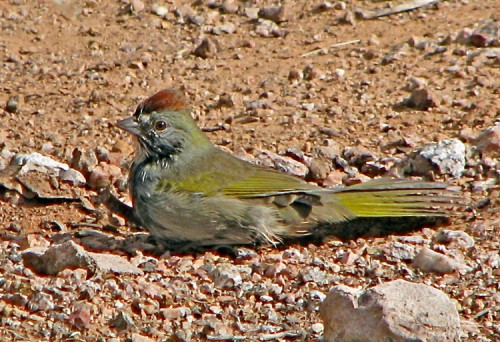 but they breed in mid- to high-elevations, so it’s just passing through our yard — although it’s possible it could stay for the winter. It looks legless because it’s belying its rep for being a secretive bird by taking a dust bath out in the open. And it looks spiky because it’s molting in fresh plumage, especially around its face, and the new feathers are still wrapped in a protective keratin casing, like the tips of shoelaces. The shoelaces’ pushing out makes a towhee itchy, and that’s probably why it’s rolling around in the gritty gravel, scratching its itchy bits. Itchy itchy towhee.
but they breed in mid- to high-elevations, so it’s just passing through our yard — although it’s possible it could stay for the winter. It looks legless because it’s belying its rep for being a secretive bird by taking a dust bath out in the open. And it looks spiky because it’s molting in fresh plumage, especially around its face, and the new feathers are still wrapped in a protective keratin casing, like the tips of shoelaces. The shoelaces’ pushing out makes a towhee itchy, and that’s probably why it’s rolling around in the gritty gravel, scratching its itchy bits. Itchy itchy towhee.
It’s good to be a vulture!
Wishing everyone a happy International Vulture Awareness Day!
I almost let it slip by due to inattention, but then there it was — a Turkey Vulture, Cathartes aura, teetering over our neighborhood, low over the end of the street, and I remembered that today’s their day!
And let me just add: PERVIOUS NOSTRIL! No carrion-clogged air inlets here after rummaging around in a ripe ribcage. No tissue to clear your nares of noxious tissue? No worries — wide-open nostrils are easy to clean of greasy shreds — just one quick sneeze or shake of the head and it’s gristle-be-gone, carcase-ex, rid-O-rot!
(Photo A.Shock, of a Liberty Wildlife vulture on the glove at Boyce Thompson Arbortetum)
That’s just how we roll around here
Two dung beetles (Canthon sp) rolling their skilfully shaped bit of a fresh cow-pie back to their abode. No effort spared. It’s what they do.
Right now, I empathize. But remember, the lowly dung beetle is a type of Scarab. It’s said that to the ancient Egyptians the scarab and its dung ball symbolized the sun god Ra rolling the solar disc across the sky each day, transforming bodies and souls the way the dung beetle turns manure into the next generation. So keep it rolling, right? (Photo E.Shock, Cochise Co, AZ)

